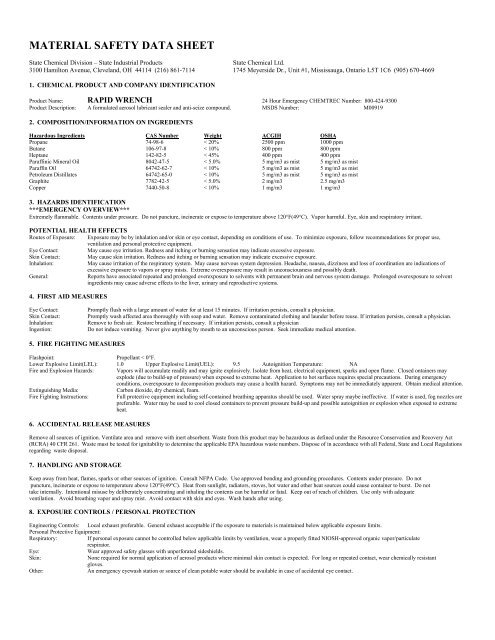Print MSDS - Miller Electric Company Publications
Print MSDS - Miller Electric Company Publications
Print MSDS - Miller Electric Company Publications
Create successful ePaper yourself
Turn your PDF publications into a flip-book with our unique Google optimized e-Paper software.
MATERIAL SAFETY DATA SHEET<br />
State Chemical Division – State Industrial Products State Chemical Ltd.<br />
3100 Hamilton Avenue, Cleveland, OH 44114 (216) 861-7114 1745 Meyerside Dr., Unit #1, Mississauga, Ontario L5T 1C6 (905) 670-4669<br />
1. CHEMICAL PRODUCT AND COMPANY IDENTIFICATION<br />
Product Name: RAPID WRENCH 24 Hour Emergency CHEMTREC Number: 800-424-9300<br />
Product Description: A formulated aerosol lubricant sealer and anti-seize compound. <strong>MSDS</strong> Number: M00919<br />
2. COMPOSITION/INFORMATION ON INGREDIENTS<br />
Hazardous Ingredients CAS Number Weight ACGIH OSHA<br />
Propane 74-98-6 < 20% 2500 ppm 1000 ppm<br />
Butane 106-97-8 < 10% 800 ppm 800 ppm<br />
Heptane 142-82-5 < 45% 400 ppm 400 ppm<br />
Paraffinic Mineral Oil 8042-47-5 < 5.0% 5 mg/m3 as mist 5 mg/m3 as mist<br />
Paraffin Oil 64742-62-7 < 10% 5 mg/m3 as mist 5 mg/m3 as mist<br />
Petroleum Distillates 64742-65-0 < 10% 5 mg/m3 as mist 5 mg/m3 as mist<br />
Graphite 7782-42-5 < 5.0% 2 mg/m3 2.5 mg/m3<br />
Copper 7440-50-8 < 10% 1 mg/m3 1 mg/m3<br />
3. HAZARDS IDENTIFICATION<br />
***EMERGENCY OVERVIEW***<br />
Extremely flammable. Contents under pressure. Do not puncture, incinerate or expose to temperature above 120°F(49°C). Vapor harmful. Eye, skin and respiratory irritant.<br />
POTENTIAL HEALTH EFFECTS<br />
Routes of Exposure: Exposure may be by inhalation and/or skin or eye contact, depending on conditions of use. To minimize exposure, follow recommendations for proper use,<br />
ventilation and personal protective equipment.<br />
Eye Contact: May cause eye irritation. Redness and itching or burning sensation may indicate excessive exposure.<br />
Skin Contact: May cause skin irritation. Redness and itching or burning sensation may indicate excessive exposure.<br />
Inhalation: May cause irritation of the respiratory system. May cause nervous system depression. Headache, nausea, dizziness and loss of coordination are indications of<br />
excessive exposure to vapors or spray mists. Extreme overexposure may result in unconsciousness and possibly death.<br />
General: Reports have associated repeated and prolonged overexposure to solvents with permanent brain and nervous system damage. Prolonged overexposure to solvent<br />
ingredients may cause adverse effects to the liver, urinary and reproductive systems.<br />
4. FIRST AID MEASURES<br />
Eye Contact: Promptly flush with a large amount of water for at least 15 minutes. If irritation persists, consult a physician.<br />
Skin Contact: Promptly wash affected area thoroughly with soap and water. Remove contaminated clothing and launder before reuse. If irritation persists, consult a physician.<br />
Inhalation: Remove to fresh air. Restore breathing if necessary. If irritation persists, consult a physician<br />
Ingestion: Do not induce vomiting. Never give anything by mouth to an unconscious person. Seek immediate medical attention.<br />
5. FIRE FIGHTING MEASURES<br />
Flashpoint: Propellant < 0°F.<br />
Lower Explosive Limit(LEL): 1.0 Upper Explosive Limit(UEL): 9.5 Autoignition Temperature: NA<br />
Fire and Explosion Hazards: Vapors will accumulate readily and may ignite explosively. Isolate from heat, electrical equipment, sparks and open flame. Closed ontainers may<br />
explode (due to build-up of pressure) when exposed to extreme heat. Application to hot surfaces requires special precautions. During emergency<br />
conditions, overexposure to decomposition products may cause a health hazard. Symptoms may not be immediately apparent. Obtain medical attention.<br />
Extinguishing Media: Carbon dioxide, dry chemical, foam.<br />
Fire Fighting Instructions: Full protective equipment including self-contained breathing apparatus should be used. Water spray maybe ineffective. If water is used, fog nozzles are<br />
preferable. Water may be used to cool closed containers to prevent pressure build-up and possible autoignition or explosion when exposed to extreme<br />
heat.<br />
6. ACCIDENTAL RELEASE MEASURES<br />
Remove all sources of ignition. Ventilate area and remove with inert absorbent. Waste from this product may be hazardous as defined under the Resource Conservation and Recovery Act<br />
(RCRA) 40 CFR 261. Waste must be tested for ignitability to determine the applicable EPA hazardous waste numbers. Dispose of in accordance with all Federal, State and Local Regulations<br />
regarding waste disposal.<br />
7. HANDLING AND STORAGE<br />
Keep away from heat, flames, sparks or other sources of ignition. Consult NFPA Code. Use approved bonding and grounding procedures. Contents under pressure. Do not<br />
puncture, incinerate or expose to temperature above 120°F(49°C). Heat from sunlight, radiators, stoves, hot water and other heat sources could cause container to burst. Do not<br />
take internally. Intentional misuse by deliberately concentrating and inhaling the contents can be harmful or fatal. Keep out of reach of children. Use only with adequate<br />
ventilation. Avoid breathing vapor and spray mist. Avoid contact with skin and eyes. Wash hands after using.<br />
8. EXPOSURE CONTROLS / PERSONAL PROTECTION<br />
Engineering Controls: Local exhaust preferable. General exhaust acceptable if the exposure to materials is maintained below applicable exposure limits.<br />
Personal Protective Equipment:<br />
Respiratory: If personal exposure cannot be controlled below applicable limits by ventilation, wear a properly fitted NIOSH-approved organic vapor/particulate<br />
respirator.<br />
Eye: Wear approved safety glasses with unperforated sideshields.<br />
Skin: None required for normal application of aerosol products where minimal skin contact is expected. For long or repeated contact, wear chemically resistant<br />
gloves.<br />
Other: An emergency eyewash station or source of clean potable water should be available in case of accidental eye contact.



